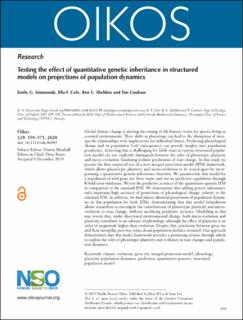| dc.contributor.author | Simmonds, Emily Grace | |
| dc.contributor.author | Cole, Ella F | |
| dc.contributor.author | Sheldon, Ben C | |
| dc.contributor.author | Coulson, Tim | |
| dc.date.accessioned | 2020-04-17T09:21:48Z | |
| dc.date.available | 2020-04-17T09:21:48Z | |
| dc.date.created | 2019-12-19T15:58:06Z | |
| dc.date.issued | 2019 | |
| dc.identifier.issn | 0030-1299 | |
| dc.identifier.uri | https://hdl.handle.net/11250/2651472 | |
| dc.description.abstract | Global climate change is altering the timing of life history events for species living in seasonal environments. These shifts in phenology can lead to the disruption of interspecific relationships with implications for individual fitness. Predicting phenological change and its population level consequences can provide insights into population persistence. Achieving this is challenging for labile traits as current structured population models do not explicitly distinguish between the roles of phenotypic plasticity and micro‐evolution, hindering realistic predictions of trait change. In this study we present the first empirical test of a new integral projection model (IPM) framework, which allows phenotypic plasticity and micro‐evolution to be teased apart by incorporating a quantitative genetic inheritance function. We parameterise this model for a population of wild great tits Parus major and test its predictive capabilities through K‐fold cross validation. We test the predictive accuracy of the quantitative genetic IPM in comparison to the standard IPM. We demonstrate that adding genetic inheritance rules maintains high accuracy of projections of phenological change, relative to the standard IPM. In addition, we find almost identical projections of population dynamics in this population for both IPMs, demonstrating that this model formulation allows researchers to investigate the contributions of phenotypic plasticity and micro‐evolution to trait change, without sacrificing predictive accuracy. Modelling in this way reveals that, under directional environmental change, both micro‐evolution and plasticity contribute to an advance of phenology, although the effect of plasticity is an order of magnitude higher than evolution. Despite this, synchrony between great tits and their caterpillar prey was reduced and population declines occurred. Our approach demonstrates that this model framework provides a promising avenue through which to explore the roles of phenotypic plasticity and evolution in trait changes and population dynamics. | en_US |
| dc.language.iso | eng | en_US |
| dc.publisher | Wiley | en_US |
| dc.rights | Navngivelse 4.0 Internasjonal | * |
| dc.rights.uri | http://creativecommons.org/licenses/by/4.0/deed.no | * |
| dc.title | Testing the effect of quantitative genetic inheritance in structured models on projections of population dynamics | en_US |
| dc.type | Peer reviewed | en_US |
| dc.type | Journal article | en_US |
| dc.description.version | publishedVersion | en_US |
| dc.source.journal | Oikos | en_US |
| dc.identifier.doi | 10.1111/oik.06985 | |
| dc.identifier.cristin | 1763113 | |
| dc.description.localcode | © 2019 Nordic Society Oikos. Published by John Wiley & Sons Ltd This is an open access article under the terms of the Creative Commons Attribution License, which permits use, distribution and reproduction in any medium, provided the original work is properly cited. | en_US |
| cristin.unitcode | 194,63,15,0 | |
| cristin.unitname | Institutt for matematiske fag | |
| cristin.ispublished | false | |
| cristin.fulltext | postprint | |
| cristin.qualitycode | 2 | |

